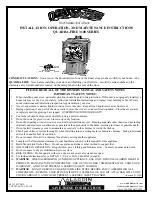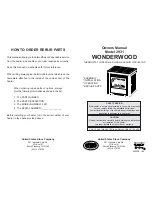
Marlene 3
12
4 ROUTINE STOVE CLEANING AND MAINTENANCE
Good maintenance will help improve the operation, efficiency and service life of the stove.
Every day, before lighting the fire, remove any unburnt residuals on the grate and the ashes in the ash pan zone.
4.11 Removing ash
The stove has a removable grate that should be cleared of ash, using the poker provided, every time before loading
fuel.
Make sure to periodically empty the ash pan, since the accumulation of ash under the grate hinders the flow of
combustion air;
otherwise the grate will overheat and may become damaged.
•
To prevent the risk of fire, allow the ashes to cool outdoors in a metal container or in the stove and
eliminate them in compliance with current local regulations.
4.12 Cleaning the glass
The glass can be cleaned using a damp cloth and normal non-abrasive detergents.
Remove any encrustations with suitable detergents, before they become dry.
The ceramic glass can withstand temperatures of around 750°C : in case of breakage, it is advisable to replace it with
another original glass.
•
Do not clean the glass during stove operation: cleaning must be carried out when the stove is cold.
4.13 Stove cladding maintenance
Clean the cladding only when the stove is cold. The ceramics are handicraft production and therefore may have minor
surface imperfections such as tiny spots or slight colour differences.
It is advisable to use a soft dry cloth to clean the ceramic surfaces; the use of detergents could highlight any flaws.
4.14 Cleaning the cast iron hotplate
Before lighting the stove for the first time, make sure to clean the hotplate with an absorbent cloth in order to remove
the protective grease.
•
Before first use and after cleaning, the hotplate should be preheated for about half an hour with the oven
door open and the bypass damper lever in position A.
For regular cleaning of the cast iron part of the hotplate, it is advisable to use slightly abrasive materials (e.g.
sandpaper or steel wool), rubbing in the direction of the surface finish.
At the end of the season it is advisable to apply a film of olive oil or neutral vaseline on the hotplate to protect it.
4.15 Cleaning the oven
It is advisable to clean the oven when half-cold or cold and every time after it is used, in order to prevent grime
forming on the surfaces.
To clean the stainless steel surfaces of the oven, use a non-abrasive detergent with a soft cloth, rinsing thoroughly to
remove all traces of detergent which could otherwise contaminate food or cause corrosion.
4.16 Cleaning the flue and baffle
A reduction in heat output is nearly always due to obstruction
of the flue. Also, the escaping of burnt gases with
odours can be the sign of an obstructed flue.
The stove flue must be cleaned at regular intervals. The amount of soot and the frequency of cleaning will depend
largely on the type of fuel and how the stove is used (i.e. low or high output).
Clean the flue pipes, proceeding as follows:
►
Clean only when the stove is cold;
►
Close all openings which are not to be cleaned;
►
Remove the flue pipes and clean them outdoors;
►
Detach and suck the deposits inside the stove, after removing the hotplate rings and their support;
►
All deposits on the grate or in the ash pan must be removed
For thorough cleaning of your stove it is advisable to remove the wood-fired oven. To carry out this operation, undo
the 4 screws fixing the oven door frame, after removing the door and frame, undo the blind nut located in the middle
of the oven at the back, then remove the oven and carry out cleaning, removing the residuals of soot.
































